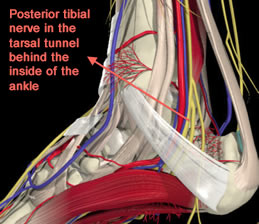Tarsal Tunnel Syndrome
What is the Tarsal Tunnel?
The tarsal tunnel describes an area that is found on the inside of the ankle next to and just below the ankle bone that is prominent. Under the skin the tunnel is covered with a thick band (the flexor retinaculum) that protects the structures contained within the tunnel—arteries, veins, tendons, and nerves as they travel from the back of the leg around the ankle and into the foot. One of these structures is the posterior tibial nerve which, if it gets compressed can cause tarsal tunnel syndrome.

What causes Tarsal Tunnel Syndrome?
- Flat feet: Because of the tilting of the heel to the outside and the “fallen” arches, the nerve can be stretched along the inside of the ankle.
- An enlarged mass that occupies space within the tunnel can compress the nerve. For example a varicose vein, ganglion, swollen tendon, bone spur or soft tissue lump.
- An injury, such as an ankle sprain can cause tissue swelling near the tunnel and compress the nerve.
- Systemic diseases such as diabetes or arthritis can cause tissue swelling and compression.
What are the symptoms?
- Tingling or a burning sensation from the nerve
- Numbness in the area of the foot, usually around the sole
- Pain around the arch of the foot
How is the condition diagnosed?
- Clinical examination with typical symptoms
- X-Ray to examine for bony spurs or arthritis
- MRI to detect abnormal swellings or tendon swelling
- Nerve conduction studies to examine for compression on the nerve
Can the problem get worse?
The symptoms can progress if associated with a flat foot that gets worse or an enlarged mass that can get bigger. It is advisable to seek specialist advice for the best treatment available.
How do you treat Tarsal Tunnel Syndrome?
Many non-operative treatments exist depending on the exact reason for the Tarsal Tunnel symptoms:
- Nonsteroidal anti-inflammatory drugs (NSAIDs), such as ibuprofen, help reduce inflammation if associated with hindfoot/midfoot arthritis.
- Rest or immobilisation of the foot in a boot can promote healing of sprained tissue
- to enable the compression on the nerve to settle.
- Physiotherapy can reduce symptoms if associated with posterior tibial tendon dysfunction on the inside of the ankle.
- Injections of steroid/local anesthetic can reduce inflammation and potentially be curative in some cases.
- Orthotic insoles or custom shoes or braces can help maintain the foot arch and limit excessive sideways movement of the heel in flat feet which can cause nerve compression.
Surgical intervention is usually advised if the symptoms are due to an isolated abnormal soft tissue mass in the tarsal tunnel.
If non-operative measures fail to improve symptoms in other conditions causing tarsal tunnel syndrome, then surgery can treat the problem causing the nerve compression.
Deciding whether surgery is necessary
Many patients are simply seeking advice on managing a problem. Surgery is advised if symptoms and disability persist even after other treatments. The exact surgery involved will depend on the “cause” of the nerve compression.
